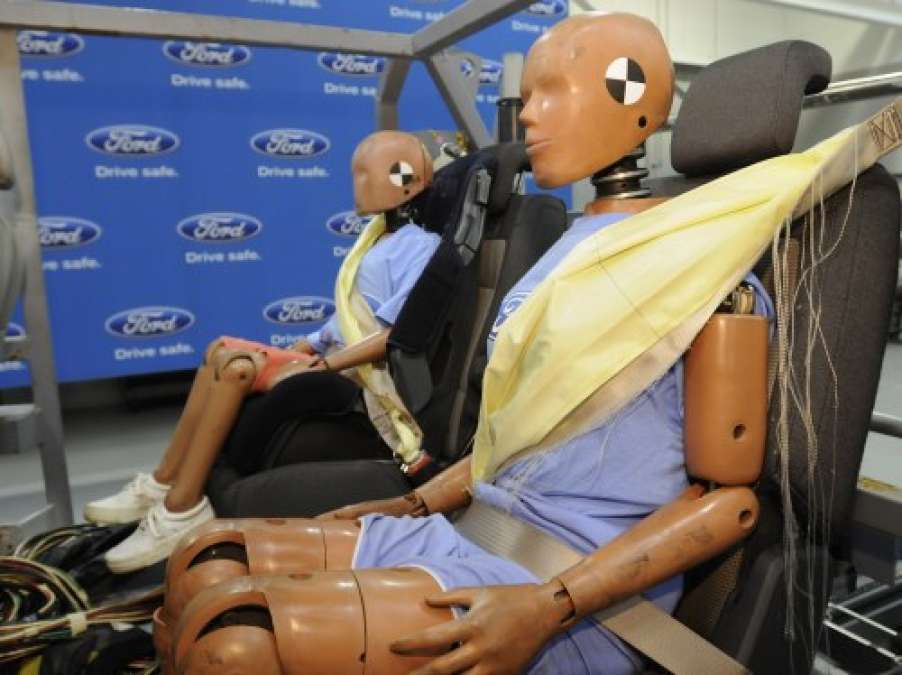Although the technology was introduced by Ford in January, the AJAC award is a recognition of Ford’s leadership in automotive technology features.
Functioning like a standard seat belt in normal everyday use, Ford's unique inflatable rear belts reduces pressure on the chest while helping to control head and neck motion. Furthermore, it does not use the traditional heat-generating chemicals to induce expansive gas.
As with any other seat belt system, a Ford vehicle’s crash-sensing system determines exactly when the inflatable belt should deploy.
According to the news release out of Ontario, Ford’s unique inflatable rear belts spreads impact forces across more than five times the area than conventional seat belts, reducing pressure on the chest while helping to control head and neck motion
According to David Mondragon, president and CEO, Ford of Canada, "Safety is a key priority at Ford and we are honored to win this year's 'Best New Technology' award for our industry-first rear inflatable seat belts."
For the record, Ford introduced inflatable rear seat belts on the 2011 Ford Explorer; and over time, Ford plans to offer the technology in vehicles globally.
I’ve written before about the degree and number of technology features that Ford has availed in automobiles the past three years. In this case, Ford Motor Company has indeed brought to market the world’s first automotive inflatable seat belts, combining attributes of traditional seat belts and airbags to provide an added level of crash safety protection for rear seat occupants.
The advanced restraint system is designed to help reduce head, neck and chest injuries for rear seat passengers, often children and older passengers who can be more vulnerable to such injuries.
According to the January news release, “Ford’s rear inflatable seat belt technology will enhance safety for rear seat passengers of all ages, especially for young children who are more vulnerable in crashes,” said Sue Cischke, Ford group vice president of Sustainability, Environment and Safety Engineering. “This is another unique family technology that builds on our safety leadership, including the most top safety ratings of any automaker.”
Uses cold compressed gas
The use of cold compressed gas instead of a heat-generating chemical reaction – which is typical of traditional airbag systems – means the inflated belts feel no warmer on the wearer’s body than the ambient temperature. The inflatable belts also fill at a lower pressure and a slower rate than traditional airbags, because the device does not need to close a gap between the belt and the occupant.
In the event of a frontal or side crash, the inflatable belt’s increased diameter more effectively holds the occupant in the appropriate seating position, helping to reduce the risk of injury.
Vehicle safety sensors determine the severity of the collision in the blink of an eye and deploy the inflatable belts’ airbags. Each belt’s tubular airbag inflates with cold compressed gas, which flows through a specially designed buckle from a cylinder housed below the seat.
The inflatable belt’s accordion-folded bag breaks through the belt fabric as it fills with air, expanding sideways across the occupant’s body in about the same amount of time it takes a car traveling at highway speed to cover a yard of distance.
-----------------------
About the Author: After 39 years in the auto industry as a design engineer, Frank Sherosky now day trades, writes articles, books and ebooks via authorfrank.com, but may be contacted here by email: [email protected]
_________________________________________________________________
Additional Reading:
Full EVs at 2011 Detroit Auto Show not so green after all
High-efficiency small cars shine at 2011 Detroit Auto Show
Ram Trucks with natural gas could set a new trend in America
Electric Avenue lights up future at 2011 Detroit Auto Show
Tesla Model S illuminates aluminum-body structure at 2011 Detroit Auto Show





